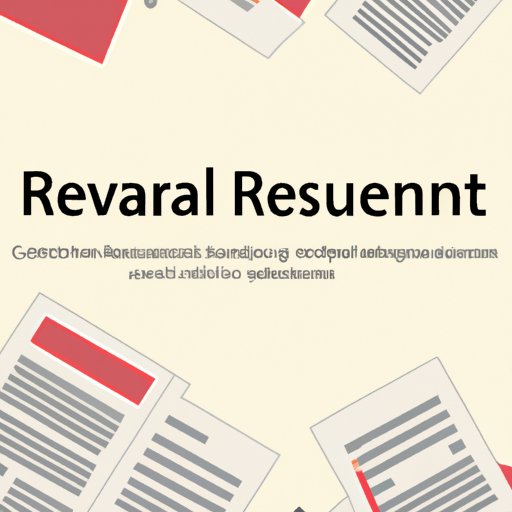Introduction
A review of literature is a critical analysis of existing scholarly work on a particular topic. It is often used as part of a larger research project, such as a dissertation or thesis. The aim of the review is to provide an overview of the current state of knowledge on the topic, identify key themes and trends, and assess the strengths and weaknesses of existing studies.
A Comprehensive Overview of the Review of Literature
The review of literature is an essential part of any research project. It allows researchers to identify existing research gaps, build on existing knowledge, and develop a research plan. Reviews of literature can be divided into two main categories: systematic reviews and narrative reviews.
Different Types of Reviews of Literature
Systematic reviews are comprehensive and structured assessments of existing research. They involve a rigorous methodology that involves searching for relevant studies, appraising them, and synthesizing the results. Systematic reviews are often used in healthcare and medical research, but are also applicable to other fields. Narrative reviews are less structured and more interpretive than systematic reviews. They provide an overview of the existing literature and draw conclusions based on the synthesis of the research.
Benefits of Conducting a Review of Literature
Conducting a review of literature can be beneficial in several ways. It can help researchers to identify gaps in existing knowledge and to determine the direction of future research. It can also provide a basis for developing new theories or hypotheses. Additionally, reviews of literature can provide valuable insights into how research findings can be applied in practice. Finally, reviews of literature can help to improve the quality of research by identifying methodological flaws and highlighting areas where further research is needed.
How to Conduct a Review of Literature: Step-by-Step Guide
Conducting a review of literature requires careful planning and preparation. The following steps outline the process for conducting a comprehensive review of literature.
Preparation for Conducting a Review
Before beginning the review process, it is important to establish a clear focus for the review. This involves selecting a specific research topic and defining the scope of the review. Once these have been established, the next step is to identify relevant sources. This involves searching for published research papers, books, conference proceedings, and other sources related to the topic.
Steps for Conducting a Review
Once the relevant sources have been identified, the next step is to read and evaluate the sources. This involves reading the sources carefully and critically assessing their relevance and quality. It is important to note down any key points and make notes of any potential critiques. After this, the researcher should begin to organize the sources into themes and sub-themes. This allows the researcher to identify similarities and differences between the sources and draw conclusions about the state of existing knowledge.

Examining Examples of High Quality Reviews of Literature
It is important to understand what constitutes a high quality review of literature. Examining examples of good reviews can help to illustrate the characteristics of well-executed reviews. The following section examines an example of a high quality review and identifies some of its key features.
Analyzing an Example of a Good Review of Literature
One example of a high quality review of literature is a systematic review of the effectiveness of cognitive behavioral therapy (CBT) for depression. The review was conducted by a team of researchers from the University of Oxford. The review included a detailed search of the literature, including databases, journals, and conference proceedings. The review also assessed the quality of the studies and synthesized the results. The study concluded that CBT was effective in treating mild to moderate depression, but further research was needed to determine its efficacy for severe depression.
Identifying Characteristics of High Quality Reviews
The review of CBT for depression is an example of a high quality review of literature. The review had several key characteristics that made it successful. First, the review had a clear focus and defined scope. Second, the review used a rigorous methodology to search for and appraise the relevant studies. Third, the review provided a comprehensive overview of the existing literature and drew meaningful conclusions from the synthesis of the research. Finally, the review highlighted areas for further research.
Conclusion
This article has provided an in-depth overview of the review of literature. It explained the purpose and different types of reviews of literature, and outlined a step-by-step guide for conducting one. Examples of high quality reviews were also examined. In summary, reviews of literature are an important part of any research project, as they allow researchers to identify existing research gaps and build on existing knowledge. Furthermore, reviews of literature can provide valuable insights into how research findings can be applied in practice.
(Note: Is this article not meeting your expectations? Do you have knowledge or insights to share? Unlock new opportunities and expand your reach by joining our authors team. Click Registration to join us and share your expertise with our readers.)
